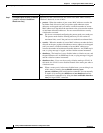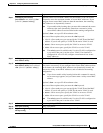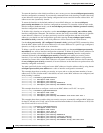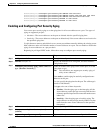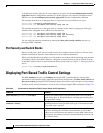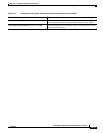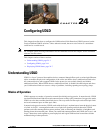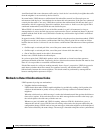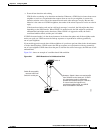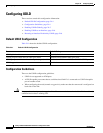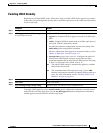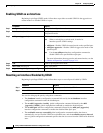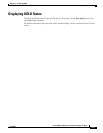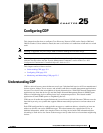
24-2
Catalyst 2960 and 2960-S Switch Software Configuration Guide
OL-8603-09
Chapter 24 Configuring UDLD
Understanding UDLD
A unidirectional link occurs whenever traffic sent by a local device is received by its neighbor but traffic
from the neighbor is not received by the local device.
In normal mode, UDLD detects a unidirectional link when fiber strands in a fiber-optic port are
misconnected and the Layer 1 mechanisms do not detect this misconnection. If the ports are connected
correctly but the traffic is one way, UDLD does not detect the unidirectional link because the Layer 1
mechanism, which is supposed to detect this condition, does not do so. In this case, the logical link is
considered undetermined, and UDLD does not disable the port.
When UDLD is in normal mode, if one of the fiber strands in a pair is disconnected, as long as
autonegotiation is active, the link does not stay up because the Layer 1 mechanisms detects a physical
problem with the link. In this case, UDLD does not take any action and the logical link is considered
undetermined.
In aggressive mode, UDLD detects a unidirectional link by using the previous detection methods. UDLD
in aggressive mode can also detect a unidirectional link on a point-to-point link on which no failure
between the two devices is allowed. It can also detect a unidirectional link when one of these problems
exists:
• On fiber-optic or twisted-pair links, one of the ports cannot send or receive traffic.
• On fiber-optic or twisted-pair links, one of the ports is down while the other is up.
• One of the fiber strands in the cable is disconnected.
In these cases, UDLD disables the affected port.
In a point-to-point link, UDLD hello packets can be considered as a heart beat whose presence
guarantees the health of the link. Conversely, the loss of the heart beat means that the link must be shut
down if it is not possible to re-establish a bidirectional link.
If both fiber strands in a cable are working normally from a Layer 1 perspective, UDLD in aggressive
mode detects whether those fiber strands are connected correctly and whether traffic is flowing
bidirectionally between the correct neighbors. This check cannot be performed by autonegotiation
because autonegotiation operates at Layer 1.
Methods to Detect Unidirectional Links
UDLD operates by using two mechanisms:
• Neighbor database maintenance
UDLD learns about other UDLD-capable neighbors by periodically sending a hello packet (also
called an advertisement or probe) on every active port to keep each device informed about its
neighbors.
When the switch receives a hello message, it caches the information until the age time (hold time or
time-to-live) expires. If the switch receives a new hello message before an older cache entry ages,
the switch replaces the older entry with the new one.
Whenever a port is disabled and UDLD is running, whenever UDLD is disabled on a port, or
whenever the switch is reset, UDLD clears all existing cache entries for the ports affected by the
configuration change. UDLD sends at least one message to inform the neighbors to flush the part of
their caches affected by the status change. The message is intended to keep the caches synchronized.



